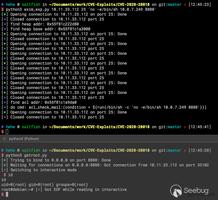201521123010 《Java程序设计》第3周学习总结

2. 书面作业
1、代码阅读
public class Test1 { private int i = 1;//这行不能修改
private static int j = 2;
public static void main(String[] args) {
geti();
Test1getj();
}
public static void geti() {
System.out.println(i);
}
public static void getj() {
System.out.println(j);
}
}
1.以上代码可否编译通过?哪里会出错?为什么?尝试改正?
2.如果创建3个Test1对象,有内存中有几个i,几个j?请分析原因?
答:
1.①不可以通过编译。②图一中第15行出错。③因为此时i变量不属于static变量。④改正如图2所示。2.①在内存中会有3个i,因为对于一个static字段来说每个类只分有一份存储空间。②在内存中会有一个j,因为对于一个非static字段来说每个对象会分一个存储空间。
图一 ----------------------------------------------------------------------------------------
图二 ----------------------------------------------------------------------------------------
2、构造函数有什么用?其编写格式是什么?如果一个类不写构造函数,它有构造函数吗?如果一个类中只有带参的构造函数,它有没有不带参数的默认构造函数?
答:
①作用是:对类进行初始化操作,实例化对象,即为对象成员变量赋初始值。②构造方法的名字要和类名一样,没有返回类型。其格式为:public 类名(){ }
③如果一个类不写构造函数,则会有一个默认的无参构造方法。
④没有。不过若需要,可显式声明一个无参构造。
3、使用java.lang.Math类的函数时,为什么不需要new?如果new Math()会产生什么错误?分析原因?
答:
①查阅java的API文档,有public final class Math extends Object,其中没有static,所以Math并非一个静态类。②会产生“The constructor Math() is not visible.”可以用类名.方法直接访问,所以就不需要new出一个实例对象来进行访问了。如下是部分源代码,可看出Math为private类。
/** * Don't let anyone instantiate this class.
*/
private Math() {}
4、什么是重载?什么是构造函数重载?在java.lang.Math类中举出1个函数重载的例子?怎么才能区分两个重载函数?
答:
①重载就是方法名相同,参数的类型或个数不同的方法。②构造函数重载就是可以写多个构造函数,参数类型或个数不同,允许方法名相同而形式参数不同的构造器同时存在的方法。
③如下图所示。(不太懂,但百度后是这样说的)
④可以通过不同的参数,比如:“void f1(char x){prt("f1(char)");}//①”
“void f1(String x){prt("f1(String)");}//②”
调用时,有:“f1('x');//①”
“f1("aabb");//②”
如图:
5、final修饰的变量不能改变,为什么如下代码可以正常运行?
final int[] NUMBS= {1,2,3,4,5};NUMBS[2] = 1;
答:
使用final关键字修饰一个变量时,是指引用变量不能变,引用变量所指向的对象中的内容还是可以改变的。 故此代码可以正常运行。
6、阅读代码EmployeeTest.java,回答:
为什么其属性均为private?这样设计有什么好处?
为Employee类增加一个无参构造函数,调用其有参构造函数,设置name为雇员1, salary为3000, hireDay的年月日为2017年3月5日。(粘贴代码)
为Employee类再增加一个有参构造函数,参数只有name与salary,hideDay为当前日期。(粘贴代码)
答:
①为了不让其示例对象直接通过 对象.属性名 来使用和修改,而是通过set属性名,get属性名,更安全,这样属性就不会随意的被赋值上任何非法的值了,可以在set属性名的方法中进行控制。②类的设计要做到“适度”,对变量的操作需要提供的就提供,不该提供的就不要提供。在满足需求的前提下,实现类的功能最小化,避免随着开发规模增加代码量太大而难于管理以及发生错乱。 >代码如下: public class Test1
{
public static void main(String[] args)
{
// fill the staff array with three Employee objects
/*为Employee类增加一个无参构造函数,调用其有参构造函数,设置name为雇员1,
* salary为3000, hireDay的年月日为2017年3月5日。(粘贴代码) */
Employee staff = new Employee();
staff.getName("雇员1");
staff.getSalary(3000);
staff.getHireDay(2017, 3, 5);
// raise everyone's salary by 5%
System.out.println("name=" + staff.getName() + ",salary=" + staff.getSalary() + ",hireDay="
+ staff.getHireDay());
}
}
class Employee
{
public Employee(String n, double s, int year, int month, int day)
{
name = n;
salary = s;
GregorianCalendar calendar = new GregorianCalendar(year, month - 1, day);
// GregorianCalendar uses 0 for January
hireDay = calendar.getTime();
}
public void getHireDay(int year, int month, int day) {
// TODO Auto-generated method stub
GregorianCalendar calendar = new GregorianCalendar(year, month - 1, day);
}
public void getSalary(double salary) {
// TODO Auto-generated method stub
this.salary = salary;
}
public void getName(String name) {
// TODO Auto-generated method stub
this.name = name;
}
public Employee() {
// TODO Auto-generated constructor stub
}
public String getName()
{
return name;
}
public double getSalary()
{
return salary;
}
public Date getHireDay()
{
return hireDay;
}
public void raiseSalary(double byPercent)
{
double raise = salary * byPercent / 100;
salary += raise;
}
}
>代码如下: public class Test1
{
public static void main(String[] args)
{
// fill the staff array with three Employee objects
/*为Employee类增加一个无参构造函数,调用其有参构造函数,设置name为雇员1,
* salary为3000, hireDay的年月日为2017年3月5日。(粘贴代码) */
Employee staff = new Employee();
staff.getName("abon");
staff.getSalary(9724);
staff.getHireDay(2017,3,10);
// raise everyone's salary by 5%
System.out.println("name=" + staff.getName() + ",salary=" + staff.getSalary() + ",hireDay="
+ staff.getHireDay());
}
}
class Employee
{
public Employee(String n, double s, int year, int month, int day)
{
name = n;
salary = s;
GregorianCalendar calendar = new GregorianCalendar(year, month - 1, day);
// GregorianCalendar uses 0 for January
hireDay = calendar.getTime();
}
public void getHireDay(int year, int month, int day) {
// TODO Auto-generated method stub
GregorianCalendar calendar = new GregorianCalendar(year, month - 1, day);
}
public void getSalary(double salary) {
// TODO Auto-generated method stub
this.salary = salary;
}
public void getName(String name) {
// TODO Auto-generated method stub
this.name = name;
}
public Employee(String name, double salary) {
// TODO Auto-generated constructor stub
this(name, salary, Calendar.getInstance().get(Calendar.YEAR),
Calendar.getInstance().get(Calendar.MONTH) + 1,
Calendar.getInstance().get(Calendar.DAY_OF_MONTH));
}
public Employee() {
// TODO Auto-generated constructor stub
}
public String getName()
{
return name;
}
public double getSalary()
{
return salary;
}
public Date getHireDay()
{
return hireDay;
}
public void raiseSalary(double byPercent)
{
double raise = salary * byPercent / 100;
salary += raise;
}
}
7、编写函数public static boolean isMondayToFriday()
功能:判断今天如果是周一到周五,直接输出如“上班时间”并返回true,否则输出“休息时间”。
提示:使用LocalDateTime, DayOfWeek
参考资料:
JAVA 8:健壮、易用的时间-日期API - ImportNew.pdf
Java8DateTimeTest.java
答:
public static boolean isMondayToFriday() { LocalDateTime time = LocalDateTime.now();
int day =(int)time.getDayOfWeek();//要使getDayOfWeek返回整型值。
if (day >= 1 && day <= 5) {
System.out.println("上班时间");
return true;
}
System.out.println("休息时间");
return false;
}
3. 码云代码提交记录
在码云的项目中,依次选择“统计-Commits历史-设置时间段”, 然后搜索并截图
4. PTA实验
题目集:jmu-Java-03-面向对象1-基础-封装继承 中的编程(5-1, 5-2, 5-3)
①进一步了解了toString的用法,通俗一点是就是用文字描述这个对象里各个变量是什么值,这个变量是什么类型的变量等。明白了之后 就可以更好的使用这个方法了。
②写第二题的时候对初始化块和静态初始化块不太熟悉,所以上网查找了一些相关代码,才顺利写下去。而在查找过程中,发现了静态初始化的优先级是最高的这一点,意外收获。
以上是 201521123010 《Java程序设计》第3周学习总结 的全部内容, 来源链接: utcz.com/z/390627.html









